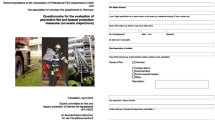Abstract
Fuel management and suppression preparedness planning are elements of forest fire management that are strongly interrelated with one another. Despite this interrelation, previous forest fire management optimization models have tended to consider these components in isolation from one another. Here we present an integer programming model that incorporates both fuel management and suppression preparedness decisions, thus providing an integrated planning framework. A series of hypothetical test landscapes are used to demonstrate the model’s functionality with easily interpretable results. A number of possible extensions to the model formulation are also discussed.


Similar content being viewed by others
References
Carmel, Y., Paz, S., Jahashan, F., & Shoshany, M. (2009). Assessing fire risk using Monte Carlo simulations of fire spread. Forest Ecology and Management, 257, 370–377.
Church, R., & ReVelle, C. (1974). The maximal covering location problem. Papers in Regional Science, 32(1), 101–118.
Dimopoulou, M., & Giannikos, I. (2001). Spatial optimization of resources deployment for forest-fire management. International Transactions in Operational Research, 8(5), 523–534.
Dimopoulou, M., & Giannikos, I. (2004). Towards an integrated framework for forest fire control. European Journal of Operational Research, 152(2), 476–486.
Haight, R. G., & Fried, J. S. (2007). Deploying wildland fire suppression resources with a scenario-based standard response model. INFOR. Information Systems and Operational Research, 45(1), 31–39.
Hof, J., Omi, P., Bevers, M., & Laven, R. (2000). A timing-oriented approach to spatial allocation of fire management effort. Forest Science, 46(3), 442–451.
Kharuk, V. I., Kasischke, E. S., & Yakubailik, O. E. (2007). The spatial and temporal distribution of fires on Sakhalin Island, Russia. International Journal of Wildland Fire, 16(5), 556–562.
Kirsch, A., & Rideout, D. (2005). Optimizing initial attack effectiveness by using performance measures. In P.N.R.S. USDA Forest Service (Ed.), System analysis in forest resources: proceedings of the 2003 symposium. General Technical Report PNW-GTR-656, Portland, OR (pp. 183–188).
Konoshima, M., Albers, H., Montgomery, C., & Arthur, J. (2010). Optimal spatial patterns of fuel management and timber harvest with fire risk. Canadian Journal of Forest Research, 40(1), 95–108.
Konoshima, M., Montgomery, C., Albers, H., & Arthur, J. (2008). Spatial-endogenous fire risk and efficient fuel management and timber harvest. Land Economics, 84(3), 449.
MacLellan, J., & Martell, D. (1996). Basing airtankers for forest fire control in Ontario. Operations Research, 44(5), 677–686.
Marianov, V., & ReVelle, C. (1992). The capacitated standard response fire protection siting problem: deterministic and probabilistic models. Annals of Operations Research, 40(1), 303–322.
Martell, D. (1982). A review of operational research studies in forest fire management. Canadian Journal of Forest Research, 12(2), 119–140.
Martell, D. (2007). Forest fire management. In A. Weintraub, C. C. Romero, T. Bjorndal, R. R. Epstein, & J. Miranda (Eds.), International series in operations research & management science. Handbook of operations research in natural resources (pp. 489–509). New York: Springer.
Martell, D. (2011). The development and implementation of forest and wildland fire management decision support systems: reflections on past practices and emerging needs and challenges. Mathematical and Computational Forestry & Natural-Resource Sciences (MCFNS), 3(1), 18–26.
Mercer, D., Haight, R., & Prestemon, J. (2008). Analyzing trade-offs between fuels management, suppression, and damages from wildfire. In T. P. Holmes, J. P. Prestemon, & K. L. Abt (Eds.) Forestry sciences. The economics of forest disturbances: wildfires, storms and invasive species (pp. 247–272). London: Springer.
Podur, J., Martell, D., & Knight, K. (2002). Statistical quality control analysis of forest fire activity in Canada. Canadian Journal of Forest Research, 32(2), 195–205.
Rideout, D., Wei, Y., Kirsch, A., & Botti, S. (2008). Toward a unified economic theory of fire program analysis with strategies for empirical modelling. In T. P. Holmes, J. P. Prestemon, & K. L. Abt (Eds.), The economics of forest disturbances: wildfires, storms and invasive species (pp. 361–380). New York: Springer.
Schmidt, D. A., Taylor, A. H., & Skinner, C. N. (2008). The influence of fuels treatment and landscape arrangement on simulated fire behavior, Southern Cascade range, California. Forest Ecology and Management, 255(8), 3170–3184.
Teague, B., Mc Leod, R., & Pascoe, S. (2010). 2009 Victorian bushfires royal commission. Final Report. Parliament of Victoria. Melbourne, Australia: Parliament of Victoria.
Wei, Y. (2012). Optimize landscape fuel treatment locations to create control opportunities for future fires. Canadian Journal of Forest Research, 42(6), 1002–1014.
Wei, Y., Rideout, D., & Kirsch, A. (2008). An optimization model for locating fuel treatments across a landscape to reduce expected fire losses. Canadian Journal of Forest Research, 38(4), 868–877.
Westerling, A. L., Hidalgo, H. G., Cayan, D. R., & Swetnam, T. W. (2006). Warming and earlier spring increase western US forest wildfire activity. Science, 313(5789), 940.
Acknowledgements
This work was supported by funding from the Bushfire Cooperative Research Centre in the form of scholarship funding to James Minas. We would like to thank Liam Fogarty and Allen Beaver from the Department of Sustainability and Environment, Victoria for providing valuable insight into fuel treatment and suppression preparedness planning considerations. We would also like to thank the guest editor and anonymous reviewers for their helpful comments on an earlier version of this paper.
Author information
Authors and Affiliations
Corresponding author
Rights and permissions
About this article
Cite this article
Minas, J., Hearne, J. & Martell, D. An integrated optimization model for fuel management and fire suppression preparedness planning. Ann Oper Res 232, 201–215 (2015). https://doi.org/10.1007/s10479-012-1298-8
Published:
Issue Date:
DOI: https://doi.org/10.1007/s10479-012-1298-8




